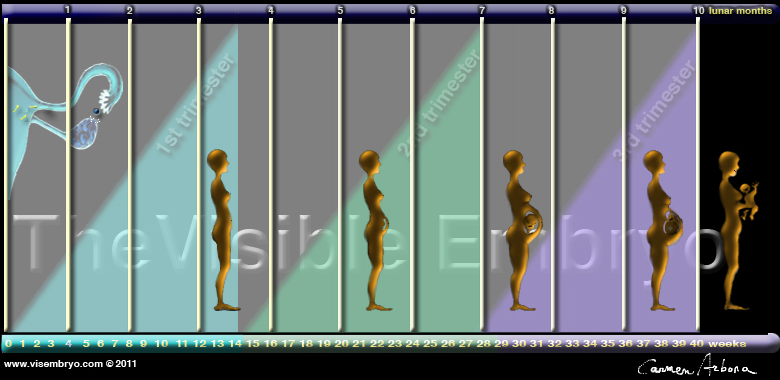|

CLICK ON weeks 0 - 40 and follow along every 2 weeks of fetal development
|
||||||||||||||||||||||||||||
|
|
|||||||||||||||||||||||||||||
|
Home | Pregnancy Timeline | News Alerts |News Archive Oct 21, 2013
|
Increase in donor eggs for in vitro Between 2000 and 2010 in the United States the number of donor eggs used for in vitro fertilization increased, and outcomes for births from those donor eggs improved.
The prevalence of oocyte (egg) donation for in vitro fertilization (IVF) has increased in the United States, but little information is available regarding maternal or infant outcomes to improve counseling and clinical decision making, according to background information in the article. Jennifer F. Kawwass, M.D., of the Emory University School of Medicine, Atlanta, and colleagues examined trends in use of donor oocytes in the United States and assessed perinatal outcomes. The study used data from the Centers for Disease Control and Prevention's National Assisted Reproductive Technology (ART) Surveillance System (NASS); fertility centers are mandated to report their data to the system, which includes data on more than 95 percent of all IVF cycles performed in the United States. Good perinatal outcome was defined as a single live-born infant delivered at 37 weeks or later weighing 5.5 lbs. or more. The researchers found that at 443 clinics (93 percent of all U.S. fertility centers) the annual number of donor oocyte cycles performed in the United States increased from 10,801 in 2000 to 18,306 in 2010, as did the percentage of such cycles that involved frozen oocytes or embryos (vs. fresh) (26.7 percent to 40.3 percent) and that involved elective single-embryo transfer (vs. transfer of multiple embryos) (0.8 percent to 14.5 percent). Good perinatal outcomes increased from 18.5 percent to 24.4 percent.
"Use of donor oocytes is an increasingly common treatment for infertile women with diminished ovarian reserve for whom the likelihood of good perinatal outcome appears to be independent of recipient age. To maximize the likelihood of a good perinatal outcome, the American Society of Reproductive Medicine recommendations suggesting transfer of a single embryo in women younger than 35 years should be considered. An editorial, "Outcomes of Donor Oocyte Cycles in Assisted Reproduction," by Evan R. Myers, M.D., M.P.H., of Duke University School of Medicine, Durham, N.C., comments on the findings of this study. "Given the promising data presented by Kawwass et al on perinatal outcomes after use of donor oocytes, the use of oocyte donors is likely to at least remain constant and may even increase. More complete data on both short- and long-term outcomes of donation are needed so donors can make truly informed choices and, once those data are available, mechanisms can be put in place to ensure that the donor recruitment and consent process at clinics is conducted according to the highest ethical standards." Abstract Objectives To quantify trends in donor oocyte cycles in the United States and to determine predictors of a good perinatal outcome among IVF cycles using fresh (noncryopreserved) embryos derived from donor oocytes. Design, Setting, and Participants Analysis of data from the Centers for Disease Control and Prevention’s National ART Surveillance System, to which fertility centers are mandated to report and which includes data on more than 95% of all IVF cycles performed in the United States. Data from 2000 to 2010 described trends. Data from 2010 determined predictors. Main Outcomes and Measures Good perinatal outcome, defined as a singleton live-born infant delivered at 37 weeks or later and weighing 2500 g or more. Results From 2000 to 2010, data from 443 clinics (93% of all US fertility centers) were included. The annual number of donor oocyte cycles significantly increased, from 10 801 to 18 306. Among all donor oocyte cycles, an increasing trend was observed from 2000 to 2010 in the proportion of cycles using frozen (vs fresh) embryos (26.7% [95% CI, 25.8%-27.5%] to 40.3% [95% CI, 39.6%-41.1%]) and elective single-embryo transfers (vs transfer of multiple embryos) (0.8% [95% CI, 0.7%-1.0%] to 14.5% [95% CI, 14.0%-15.1%]). Good perinatal outcomes increased from 18.5% (95% CI, 17.7%-19.3%) to 24.4% (95% CI, 23.8%-25.1%) (P < .001 for all listed trends). Mean donor and recipient ages remained stable at 28 (SD, 2.8) years and 41 (SD, 5.3) years, respectively. In 2010, 396 clinics contributed data. For donor oocyte cycles using fresh embryos (n = 9865), 27.5% (95% CI, 26.6%-28.4%) resulted in good perinatal outcome. Transfer of an embryo at day 5 (adjusted odds ratio [OR], 1.17 [95% CI, 1.04-1.32]) and elective single-embryo transfers (adjusted OR, 2.32 [95% CI, 1.92-2.80]) were positively associated with good perinatal outcome; tubal (adjusted OR, 0.72 [95% CI, 0.60-0.86]) or uterine (adjusted OR, 0.74 [95% CI, 0.58-0.94]) factor infertility and non-Hispanic black recipient race/ethnicity (adjusted OR, 0.48 [95% CI, 0.35-0.67]) were associated with decreased odds of good outcome. Recipient age was not associated with likelihood of good perinatal outcome. Original press releas:http://media.jamanetwork.com/news-item/increase-seen-donor-eggs-vitro-fertilization-improved-outcomes/ |
||||||||||||||||||||||||||||